Network Centricity Requires More Than Circuits and Wires
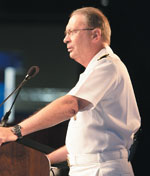 |
| Adm. Edmund P. Giambastiani Jr., USN, is the vice chairman of the Joint Chiefs of Staff. |
Despite years of discussion on the topic, the U.S. Defense Department is keeping its focus on interoperability. However, the department has undergone a shift from efforts directed primarily at developing the technology necessary to make broad intercommunications possible to work that concentrates on establishing the policies and doctrine necessary for communicators to use available resources. Military leaders say that for the
During AFCEA’s TechNet International 2006 held June 19-20 at the
TechNet 2006 began with a plenary session with speaker Adm. Edmund P. Giambastiani Jr., USN, vice chairman of the Joint Chiefs of Staff. The admiral emphasized the need for jointness and information sharing among the services and the
Adm. Giambastiani also used his speech as an opportunity to speak about acquisitions in the military and what the Defense Department is looking for in new products. “We are much more effective as a joint force,” he said. “Anything that doesn’t work in a joint environment will meet with heavy weather.”
The admiral explained that the writers of the Quadrennial Defense Review (QDR) are now the initiators of the QDR. The items in the review will be examined under the Joint Capabilities Portfolio, which has four categories: joint command and control, joint network-centric operations, joint logistics and battlespace awareness. The intent is to acquire the items listed in the QDR and to accelerate deliveries to the joint warfighter, he added.
The admiral went on to speak about irregular warfare entities and networks. “These folks are networks, and if you don’t think a network took down [Abu Musab al-] Zarqawi [in June], you are very mistaken,” Adm. Giambastiani stated.
 |
| Discussing multilevel security intelligence strategies are (l-r) panel moderator Dale W. Meyerrose, associate director of national intelligence and chief information officer, Office of the Director of National Intelligence; Gary Frisvold, chief, Information Technology Directorate Management Services, National Security Agency; Dr. Robert H. Laurine Jr., chief information officer, director, Enterprise Operations Directorate, National Geospatial-Intelligence Agency; Tom Hall, deputy for strategy and architecture, Central Intelligence Agency; and Col. Timothy M. O’Hara, USA, chief information officer/G-6, director, U.S. Army Signal Activity, U.S. Army Intelligence and Security Command. |
Meyerrose also mentioned a new process for accreditation because “everyone has a stake in certifying and accrediting information systems,” and accreditation is no longer serving the government as well as it should.
Panelist Gary Frisvold, chief, Information Technology Directorate Management Services, National Security Agency (NSA), stated that requirements are driven by information sharing and networks and that the NSA’s customers are demanding the ability to share information more easily. He also discussed the increase in the number of cyberthreats and the need to create cross-domain solutions to deal with those threats. “Our security solutions are often lagging,” Frisvold said. In MLS, Frisvold added, the focus needs to be on data, not just systems.
Tom Hall, director of strategy and architecture, Central Intelligence Agency (CIA), explained that people working in espionage do not want to share their information, so information technology people get stuck in the middle. Hall argued that each time a security failure occurs, the intelligence community creates a new network and numerous networks create a barrier to information sharing.
Panelist Col. Timothy M. O’Hara,
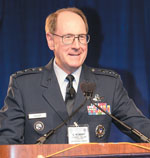 |
| Lt. Gen. C. Robert Kehler, USAF, is deputy commander, U.S. Strategic Command. |
Network centricity is the future, the general said. To achieve its goals, the military is going to have to change its views from collecting and ensuring data security to sharing information. “Information sharing is a strategic advantage,” Gen. Kehler emphasized.
The foundation for network centricity will be the Global Information Grid (GIG), which STRATCOM operates and protects. The general also offered details about the Strategic Knowledge Integration Web (SKIWEB) used by his command to share information. In addition to providing real-time command status, scrolling news and information about significant events and announcements, SKIWEB has a blogging feature to facilitate information sharing. Troops at any level can communicate with the STRATCOM commander by using this tool. They “buy their way into the blog” not by rank but by the value of the information they have to provide. In this case, the information supercedes the chain of command. “We have a command chain at STRATCOM, but not an information chain,” Gen. Kehler said.
Before closing his speech, the general imparted the importance of information technology to
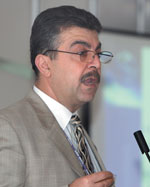 |
| Badri Younes, director, Spectrum Management, Office of the Assistant Secretary of Defense for Networks and Information Integration, speaks at the Defense Information Systems Agency Theater presentation. Younes talks about spectrum and the issues facing its use and preservation. |
Younes argued that spectrum is intertwined with economic stability and that the
In his presentation, Younes talked about the Defense Department’s strategic plans for spectrum saying that any future loss of spectrum will come at the cost of
“One way to have better spectrum usage is better planning,” Younes declared. The way ahead for spectrum planning is to pursue international and national partnerships.
 |
| Participating in “A Commanders’ Panel on Network-Enabled Operations” are (l-r) Brig. Gen. O.G. Mannon, USAF, deputy director, Special Operations, J-37, the Joint Staff; Rear Adm. Ronald H. Henderson Jr., USN, deputy director for Operations, J-3, the Joint Staff; Brig. Gen. Joseph F. Dunford Jr., USMC, director, Operations Division, Headquarters U.S. Marine Corps; and Brig. Gen. Kevin J. Bergner, USA, special assistant to the president and senior director for Iraq, National Security Council. |
Gen. Dunford gave specific examples of when he had limited situational awareness. Not only were on-the-move communications difficult for the Marines, but stationary communications also proved to be a challenge. He asserted that communications were not a driving force to victory and that network-centric capability should be pushed down to squad level in the Marine Corps. In the
In contrast to the Marines’ experiences, Brig. Gen. O.G. Mannon, USAF, deputy director, Special Operations, J-37, the Joint Staff, said that during his service as deputy commanding general of Multinational Force Northwest in
Gen. Mannon declared that the network allowed troops to fuse operations and intelligence that otherwise would have remained separate. They could stay ahead of the adversary by sharing information more quickly and could even integrate data obtained from Iraqi governors and sheiks.
Rear Adm. Ronald H. Henderson Jr., USN, deputy director for operations, J-3, the Joint Staff, said that at the strategic level the military has a very good idea of what is happening and leaders are looking to push the capability to the tactical level. He also told the audience about the role the network plays in his job to provide information and military advice to decision makers in
Gen. Mannon added that special operations cover tactical, operational and strategic levels. Network centricity allows troops to use economy of force and has reduced the planning cycle from 96 hours to about one hour. “[This] was unheard of even up to about a year ago,” he exclaimed. While the general believes network centricity has improved the military’s ability to support troops on the ground, he shared some suggestions for the future. He informed attendees that the military would need more agile communications and added that the military has too many systems in general and too many systems that do not communicate with each other.
During the question-and-answer period, commanders said their wish list of capabilities included on-the-move, over-the-horizon, reliable, solid voice communications at the command level.
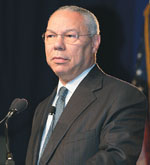 |
| Gen. Colin L. Powell, USA (Ret.), is the former secretary of state and the former chairman of the Joint Chiefs of Staff. |
Gen. Powell also touted the importance of information sharing. When he was head of the State Department, Powell said he told employees he wanted them always to be online. Soon, they all wanted BlackBerries. “We changed the culture of the State Department,” he explained. He also encouraged the government and industry to take advantage of “young kids who are wired” and use information and technology to stay ahead.
In addition, Gen. Powell offered his opinion about the necessity of remaining on good terms with other democracies, despite disagreements. He told the crowd that the
The general also shared his views on staying the course in
Throughout his speech, Gen. Powell gave examples of the
 |
| Military and industry leaders discuss the barriers to integrating Internet protocol and network centricity. Panelists are (l-r) Larry Rhue, senior vice president, Strategic Development, General Dynamics C4 Systems; Maj. Gen. Carlos D. Pair, USA, defense business systems acquisition executive, Office of the Undersecretary of Defense (Business Transformation); Art Fritzson, vice president, Booz Allen Hamilton; Maj. Gen. William T. Lord, USAF, director, Information, Services and Integration, Secretary of the Air Force Office of Warfighting Integration and Chief information Officer; and moderator Maj. Gen. J. David Bryan, USA (Ret.), vice president and deputy, Defense Group, Northrop Grumman Information Technology. |
Maj. Gen. William T. Lord, USAF, director, information, services and integration, Secretary of the Air Force Office of Warfighting Integration, and Chief Information Officer, spoke about how information sharing has changed the battlefield. In conventional warfare, fighting was force-on-force and winning required having more troops than the enemy. With network centricity, mobility, speed and precision dominate. Gen. Lord informed the audience of the future of close air support, explaining that after using IP connectivity to link air, space and ground networks, providing interoperability and integration among forces, the “good guys” had to leverage connectivity to find the “bad guys.” To eliminate targets, the network had to integrate people with eyes on the target and sensors, weapons, shooters and other elements.
Gen. Lord also reiterated concerns voiced earlier in the conference that not only do issues with technology have to be overcome, but also cultural problems and process problems have to be solved.
Panelist Art Fritzson, vice president, Booz Allen Hamilton, picked up where Gen. Lord left off by describing network centricity problems such as getting everyone to speak the same language—or be compatible—and building trust between networks. Fritzson said it is imperative to achieve platform independence and used the example of home-theater compatibility. In what he described as a very competitive field, the leaders in electronics equipment cooperated and determined standards for their products. Fritzson explained how, regardless of the brand, everyone knows what the white, red and yellow plugs on home entertainment electronics mean. Also, most people know that the big right-pointing arrow means play and a square means stop. “They arrived at a set of ideas,” Fritzson declared.
He then explained that IP does not have this commonality. “To achieve network centricity, you have to go beyond what users agree to,” he stated. The information technology world needs some sort of plug-and-play capability.
Fritzson continued with a discussion of network centricity and its challenges on the battlefield. He explained that some Web sites had true network-centric operating agility, but the military challenge is that real information means real people’s lives. To solve the incompatibility problem and foster network centricity, Fritzson promoted getting legacy systems to agree on specifications in a secure way. “We could get so much more out of these systems,” he said.
Fritzson then turned his attention to the acquisition process, advocating a change in the acquisition model. For network centricity, a requirements analysis is necessary to discover what capabilities are available or in development before new ones are created. Also, before acquired systems are deployed, developers should be required to publish information about the products in case they can satisfy a capability someone else needs. “If we changed nothing but the acquisition model, we’d have net-centricity,” Fritzson claimed. If everything changes but the acquisition model, network centricity will not be obtained, he added.
Gen. Bryan concluded the presentation portion of the panel by sharing that the military and industry are on the edge and ready to pull all the pieces together, but it comes down to culture and a willingness to really embrace the network-centric environment. “The great potential is there, yet the challenges still lie before us,” he related.
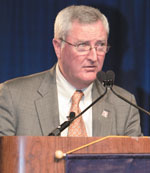 |
| John F. Killian, president of Verizon Business, Verizon Communications, speaks about key trends in global information technology. |
Convergence of capabilities requires bringing together networks and technology. Today’s converged networks are flexibleand efficient. According to Killian, convergence has made possible the intelligent network that cares about who users are, what credentials they have and what information they can access.
Connectivity means anytime, anywhere access to the GIG. Killian mentioned the ability to plug and play securely and seamlessly. He also raised two key questions: How do military and industry make information available at the right time to everyone who needs it, and how do they keep it out of the hands of those whom they do not want to have it?
The final C—collaboration—is what Killian calls the key to the future: government and industry pursuing a mutually beneficial relationship that allows industry to develop what government needs.
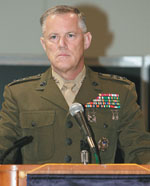 |
| Moderating the J-6 Panel, Lt. Gen. Robert M. Shea, USMC, director for Command, Control, Communications and Computers, J-6, the Joint Staff, leads a discussion on information sharing across the U.S. Defense Department. In addition to Gen. Shea, the panel included two brigadier generals, a rear admiral and one government civilian. |
Debra Filippi, director of information sharing, Office of the Assistant Secretary of Defense for Networks and Information Integration/Defense Department Chief Information Officer, said near-term efforts involve developing a federal information-sharing environment for terrorist information and developing the Defense Department Information Sharing Strategy per the QDR. Long-term efforts include creating an environment in which the
Brig. Gen. Susan S. Lawrence, USA, J-6, U.S. Central Command (CENTCOM), broached the subjects of how to share releasable information or knowledge securely with any authorized user and the difficulties of sharing information with coalition partners. Her suggestions to industry were to develop Web data guards, cross-domain chat capability, spectrum management tools and the network common operating picture. The general explained that CENTCOM has 64 countries represented in its
Rear Adm. Nancy Brown, USN, J-6, U.S. Northern Command, added to this discussion by explaining the reverse situation. She stated that 70 percent of the information the
Similar to Gen. Lawrence, Brig. Gen. Michael J. Basla, USAF, J-6, U.S. Transportation Command, appealed directly to the audience with the opportunities he sees as available to defense and industry. His list included a global token-based authentication capability, the National Information Assurance Policy, smart networks, biometrics for network access, the protection of information at rest and information in motion, and software that is secure by design.
Web Resources
TechNet 2006: www.afcea.org/events/technetinternational
MLS Panel Podcasts: www.afcea.org/signal/podcasts.asp




Comments